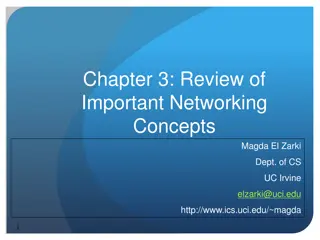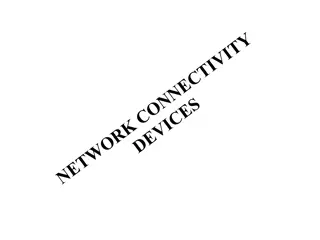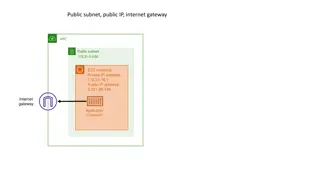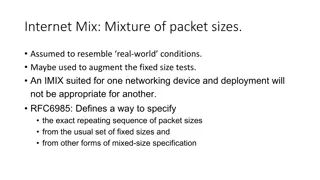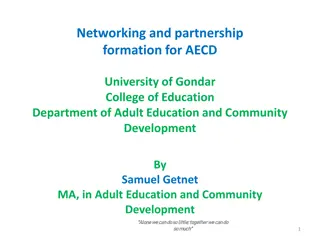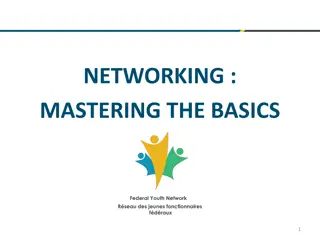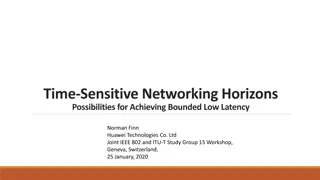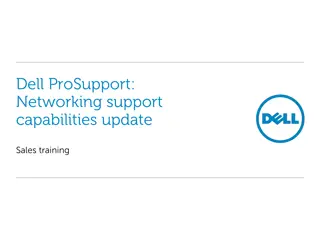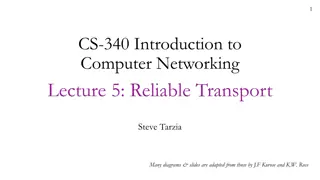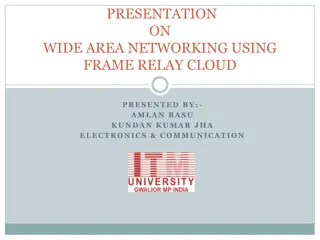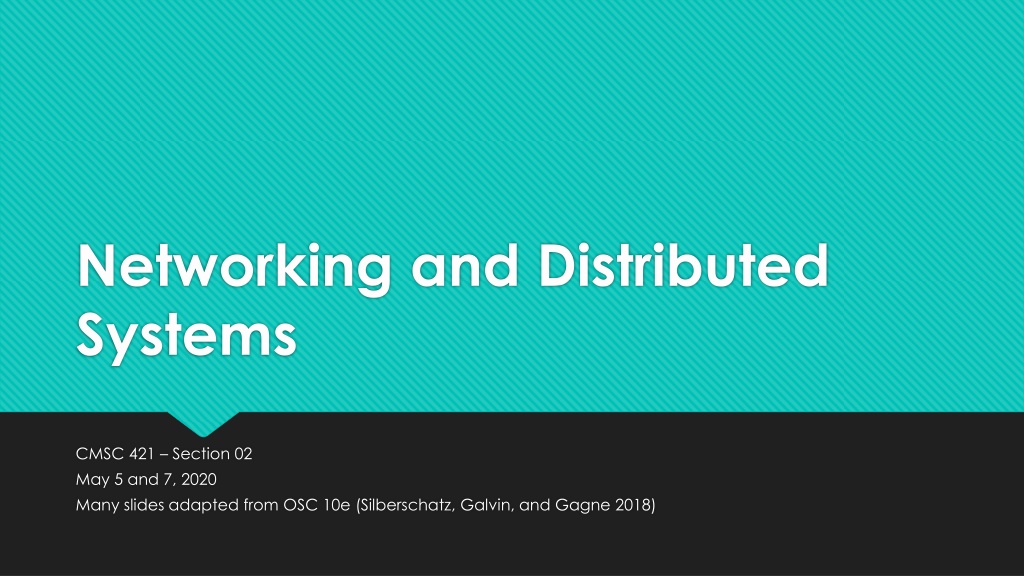
Networked and Distributed Systems Overview
Explore the fundamentals of networked and distributed systems, including the OSI model, communication structures, Berkeley Sockets, distributed system models, fault tolerance, and more. Learn about the benefits of distributed systems such as resource sharing, computation speedup, load balancing, and reliability. Discover the network structures like LANs and their components for efficient communication.
Download Presentation

Please find below an Image/Link to download the presentation.
The content on the website is provided AS IS for your information and personal use only. It may not be sold, licensed, or shared on other websites without obtaining consent from the author. If you encounter any issues during the download, it is possible that the publisher has removed the file from their server.
You are allowed to download the files provided on this website for personal or commercial use, subject to the condition that they are used lawfully. All files are the property of their respective owners.
The content on the website is provided AS IS for your information and personal use only. It may not be sold, licensed, or shared on other websites without obtaining consent from the author.
E N D
Presentation Transcript
Networking and Distributed Systems CMSC 421 Section 02 May 5 and 7, 2020 Many slides adapted from OSC 10e (Silberschatz, Galvin, and Gagne 2018)
Outline Networked and Distributed Systems OSI Model Communication Structure Network-oriented Systems Berkeley Sockets Distributed System Model Byzantine Fault Tolerance Peer-to-peer Systems Distributed Filesystems
Networked and Distributed Systems A distributed system is a collection of loosely coupled nodes interconnected by a communications network Nodes variously called processors, computers, machines, hosts Site is location of the machine, node refers to specific system Generally a server has a resource a client node at a different site wants to use
Networked and Distributed Systems Nodes may exist in a client-server, peer-to-peer, or hybrid configuration. In client-server configuration, server has a resource that a client would like to use In peer-to-peer configuration, each node shares equal responsibilities and can act as both clients and servers A hybrid configuration combines characteristics of both of the above Communication over a network occurs through message passing All higher-level functions of a standalone system can be expanded to encompass a distributed system
Why? Resource sharing Sharing files or printing at remote sites Processing information in a distributed database Using remote specialized hardware devices such as graphical processing units (GPUs) and other compute devices (FPGAs, ASICs) Computation speedup Distribute portions of computations among various sites to run concurrently Load balancing: moving jobs to more lightly-loaded sites Reliability Detect and recover from site failure, function transfer, reintegrate failed site
Network Structure Local-Area Network (LAN) designed to cover small geographical area, usually limited to within one building or site Consists of multiple computers (workstations, laptops, mobile devices), peripherals (printers, storage arrays), switches, and routers providing access to other networks Ethernet and/or Wireless (WiFi) most common way to construct LANs Ethernet defined by standard IEEE 802.3 with speeds typically varying from 10Mbps (original 802.3 specification 1983) to 400Gbps (802.3cn 2019). Typically transmitted over copper wire, but also sometimes over optical cable WiFi defined by standard IEEE 802.11 with speeds typically varying from 1Mbps (original 802.11 specification 1997) to about 20Gbps (802.11ay 2020). Both standards constantly evolving
Network Structure Wide-Area Network (WAN) links geographically separated sites Point-to-point connections via links Telephone lines, leased (dedicated data) lines, optical cable, microwave links, radio waves, and satellite channels Implemented via routers to direct (route) traffic from one network to another The Internet enables hosts world wide to communicate Speeds vary Many backbone providers have speeds at 40-100Gbps Local Internet Service Providers (ISPs) are usually significantly slower WAN links constantly being upgraded WANs and LANs interconnect, similar to cell phone network Cell phones use radio waves to cell towers Towers connect to other towers and to the POTS
Name Resolution Each computer system in a network is usually identified by a unique name Each potential server on a system is identified by a unique port number Identification of services on a remote system can be done by <hostname, port> pairs The Domain Name System (DNS) specifies the naming structure of hosts, as well as providing for name to address resolution over the Internet Originally specified in Internet Engineering Task Force RFC 882 and 883 (November 1983)
OSI Model Networked communication is specified in a layered model known as the Open Systems Interconnect (OSI) Model Specifies a seven layer model, where each higher level builds off the services provided by the layers beneath it This is a theoretical model and often in practice it is not quite so clearly defined Developed in the late 1970s to formalize earlier work done in network protocols Most widely deployed stack is the TCP/IP model TCP/IP has less layers than the OSI Model, but some portions of each layer in TCP/IP would be in multiple layers of the OSI Model
Layers of the OSI Model Layer 1: Physical Layer Defines mechanical and electrical details of the physical connection layer between hosts Specifies the conversion of bits into electrical signals, radio signals, etc. Defines network topology and how remote networks are connected Layer 2: Data-link Layer Defines communication between two directly connected hosts in terms of frames of data Defines error correction measures for the physical layer Defines framing mechanisms for identifying communication boundaries 802.3, 802.11, Point-to-Point Protocol
Layers of the OSI Model Layer 3: Network Layer Provides connections and routing for packets over the Data-link Layer Does not necessarily guarantee reliable communication of packets between nodes or sites (but may optionally do so) IPv4, IPv6, IGMP, IPX, AppleTalk Layer 4: Transport Layer Responsible for message transfer between clients Partitions messages into packets for Layer 3 Responsible for ordering and reliable delivery if needed TCP, UDP, UDPLite
Layers of the OSI Model Layer 5: Session Layer Implements sessions and defines process-to-process communication protocols NetBIOS, PPTP, RTP, Named Pipes, SPDY Layer 6: Presentation Layer Implements protocols for resolving difference between formats used on communicating nodes Deals with character set conversions, etc Layer 7: Application Layer Interactions with users and definitions of standard protocols used by applications FTP, HTTP, NFS, DHCP, DNS, etc.
TCP/IP Every host has a name and an associated IP address Hierarchical and segmented Sending system checks routing tables and locates a router to send packet Router uses segmented network part of IP address to determine where to transfer packet This may repeat among multiple routers May also fragment packets into smaller chunks if needed by communication medium Destination system receives the packet Packet may be complete message, or it may need to be reassembled into larger message spanning multiple packets
TCP/IP Within a network, how does a packet move from sender (host or router) to receiver? Every Ethernet/WiFi device has a medium access control (MAC) address Two devices on same LAN communicate via MAC address If a system needs to send data to another system, it needs to discover the IP to MAC address mapping Uses address resolution protocol (ARP) A broadcast or multicast packet uses a special network address to signal that all hosts should receive and process the packet Not forwarded by routers to different networks
Transport Layer Protocols Once a host with a specific IP address receives a packet, it must somehow pass it to the correct waiting process Transport protocols TCP and UDP identify receiving and sending processes through the use of a 16-bit port number Allows host with single IP address to have multiple server/client processes sending/receiving packets Well-known port numbers are used for many services FTP port 21 Secure Shell port 22 SMTP port 25 HTTP port 80 Transport protocol can be simple or can add reliability to network packet stream
User Datagram Protocol UDP is unreliable bare-bones extension to IP with addition of port number Since there are no guarantees of delivery in the lower network (IP) layer, packets may become lost Packets may also be received out-out-order UDP is also connectionless no connection setup at the beginning of the transmission to set up state Also no connection tear-down at the end of transmission UDP packets are also called datagrams UDPLite makes UDP even more barebones by removing checksums that are unnecessary over a reliable physical medium
Transmission Control Protocol TCP is both reliable and connection-oriented In addition to port number, TCP provides abstraction to allow in-order, uninterrupted byte- stream across an unreliable network Whenever host sends packet, the receiver must send an acknowledgement packet (ACK). If ACK not received before a timer expires, sender will resend. Sequence numbers in TCP header allow receiver to put packets in order and notice missing packets Connections are initiated with series of control packets called a three-way handshake Connections also closed with series of control packets
Transmission Control Protocol Receiver can send a cumulative ACK to acknowledge series of packets Server can also send multiple packets before waiting for ACKs Takes advantage of network throughput Flow of packets regulated through flow control and congestion control Flow control prevents sender from overrunning capacity of receiver Congestion control approximates congestion of the network to slow down or speed up packet sending rate
Berkeley Sockets Communications API to link multiple systems using (usually) the TCP/IP protocol stack Originated in the 4.2BSD Unix System in 1983 BSD: Berkeley Software Distribution A Unix-derived OS that was developed at the University of California Berkeley Still maintained today through systems such as FreeBSD, NetBSD, OpenBSD, etc. One of the primary free competitors to Linux in the server-space Specifies a series of system calls used for network communication and a mapping onto the VFS socket(), bind(), listen(), accept(), connect(), recv(), send(), recvfrom(), sendto() Defines a message-passing like mechanism for remote communication Widely implemented on most OSes today
Network-oriented Systems Two main types Network Operating Systems Users are aware of multiplicity of machines Distributed Operating Systems Users not aware of multiplicity of machines
Network Operating Systems Users are aware of multiplicity of machines Access to resources of various machines is done explicitly by: Remote logging into the appropriate remote machine (SSH) ssh kristen.cs.yale.edu Transferring data from remote machines to local machines, via the File Transfer Protocol (FTP) mechanism Upload, download, access, or share files through cloud storage Users must change paradigms establish a session, give network-based commands, use a web browser More difficult for users
Distributed Operating Systems Users not aware of multiplicity of machines Access to remote resources similar to access to local resources Data Migration transfer data by transferring entire file, or transferring only those portions of the file necessary for the immediate task Computation Migration transfer the computation, rather than the data, across the system Via remote procedure calls (RPCs) Via messaging system
Distributed Operating Systems Process Migration execute an entire process, or parts of it, at different sites Load balancing distribute processes across network to even the workload Computation speedup subprocesses can run concurrently on different sites Hardware preference process execution may require specialized processor Software preference required software may be available at only a particular site Data access run process remotely, rather than transfer all data locally
Robustness in Distributed Systems Hardware failures can include failure of a link, failure of a site, and loss of a message. A fault-tolerant system can tolerate a certain level of failure Degree of fault tolerance depends on design of system and the specific fault The more fault tolerance, the better! Involves failure detection, re-configuration, and recovery
Failure Detection Detecting hardware failure is difficult To detect a link failure, a heartbeat protocol can be used Assume Site A and Site B have established a link At fixed intervals, each site will exchange an I-am-up message indicating that they are up and running If Site A does not receive a message within the fixed interval, it assumes either (a) the other site is not up or (b) the message was lost Site A can now send an Are-you-up? message to Site B If Site A does not receive a reply, it can repeat the message or try an alternate route to Site B
Failure Detection If Site A does not ultimately receive a reply from Site B, it concludes some type of failure has occurred However, Site A cannot determine exactly why the failure has occurred Some possibilities: - Site B is down - The direct link between A and B is down - The alternate link from A to B is down - The message has been lost
Re-configuration and Recovery When Site A determines a failure has occurred, it must reconfigure the system: If the link from A to B has failed, this must be broadcast to every site in the system If a site has failed, every other site must also be notified indicating that the services offered by the failed site are no longer available When the link or the site becomes available again, this information must again be broadcast to all other sites
Byzantine Faults and Failures So far we have assumed that failures are caused by lost nodes or broken network connections Sometimes nodes might fail in more interesting ways Consider both benign and malicious failures Especially in systems that require consensus For instance, consider a node that responds differently to certain nodes than to others Such a fault is known as a Byzantine Fault A Byzantine Failure is one where a system that requires consensus is broken due to a Byzantine Fault
The Byzantine Generals Problem We imagine that several divisions of the Byzantine army are camped outside an enemy city, each division commanded by its own general. The generals can communicate with one another only by messenger. After observing the enemy, they must decide upon a common plan of action. However, some of the generals may be traitors, trying to prevent the loyal generals from reaching agreement. The generals must have an algorithm to guarantee that A. All loyal generals decide upon the same plan of action B. A small number of traitors cannot cause the loyal generals to adopt a bad plan. [1] [1] Lamport, L.; Shostak, R.; Pease, M. (1982). "The Byzantine Generals Problem". ACM Transactions on Programming Languages and Systems. 4 (3): 387 389. https://www.microsoft.com/en-us/research/uploads/prod/2016/12/The-Byzantine-Generals-Problem.pdf
The Byzantine Generals Problem A proper solution to the Byzantine Generals problem requires at least 3m + 1 generals to be present, where m is the number of traitorous generals. That is to say that in order for a system to be resistant to a one node Byzantine Fault, there must be at least 4 nodes within the system This assumes that messages are not changed in transit, but that individual nodes may (for whatever reason) lie about the information received when communicating with other nodes Signature schemes may be used to lower the bound on the number of functioning nodes
Byzantine Fault Tolerance and Peer-to-Peer Systems Byzantine Fault Tolerance is needed in many distributed systems in order to prevent these types of faults from corrupting the state of the system Cryptocurrencies such as Dogecoin, Bitcoin, Litecoin, and Ethereum are examples of BFT systems that are in common use today As are any other systems that use Blockchain technology Peer-to-peer systems often employ various complex BFT schemes to ensure correctness
Peer-to-peer Systems A peer-to-peer systems is a distributed system where a client-server model is not present That is to say all nodes can act both as a client of the network and as one offering services to the network Consider systems like cryptocurrencies and BitTorrent
Distributed Filesystems A Distributed Filesystem (DFS) is a system that stores data for access on a distributed system Clients, servers, and storage devices may be dispersed amongst some or all of the nodes in the distributed system file data is not centralized! Distributed filesystems have problems of load-balancing and data distribution that are not present in on-disk filesystems that are limited to a single node These systems must tackle the problems of keeping data close to where it is needed, while ensuring that consistency is preserved on all nodes in the distributed system As many systems may be attempting to access files in the DFS at the same time, especially in a large cluster, efficiency is of paramount concern!
Cluster Based DFS Built to be more fault-tolerant and scalable than a client-server filesystem setup Examples include the Google File System (GFS) and Hadoop Distributed File System (HDFS) Clients connected to master metadata server and several data servers that hold chunks (portions) of files Metadata server keeps mapping of which data servers hold chunks of which files As well as hierarchical mapping of directories and files File chunks replicated n times


